- Home
- Resurrection ▾
-
Learn ▾
- Free library
- Glossary
- Documents
- Initiation
-
Shaped fabrics
- Introduction
- Popularization
- Definitions
- Le métier de façonné
- Principes du façonné
- Mécaniques de façonné
- Le jeu des crochets
- Les cartons
- Chaîne des cartons
- Mécanique 104 en détail
- Pour en finir
- Montage façonné
- Empoutage 1/3
- Empoutage 2/3
- Empoutage 3/3
- Punching, hanging and dip
- Autres façonnés
- Façonnés et Islam
-
Cours de tissage 1912
- Bâti d'un métier
- Le rouleau arrière
- Les bascules
- Formation du pas
- Position de organes
- Mécanique 104 Jacquard
- Fonctionnement 104
- Lisage des cartons
- Le battant du métier
- Le régulateur
- Réduction et régulateur
- Mise au métier d'une chaîne
- Mise en route du métier
- Navettes à soie
- Battage
- Ourdissage mécanique
- Préparation chaînes et trames
- Equipment ▾
- Chronicles ▾
- Fabrics ▾
- Techniques ▾
- Culture ▾
- Language ▾
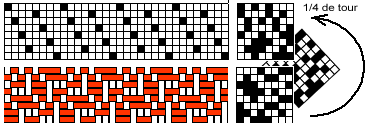
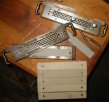
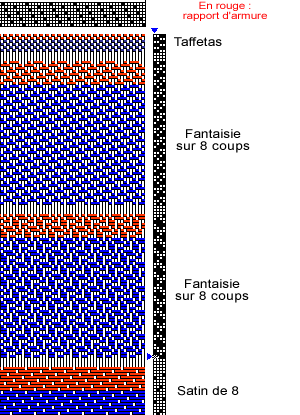
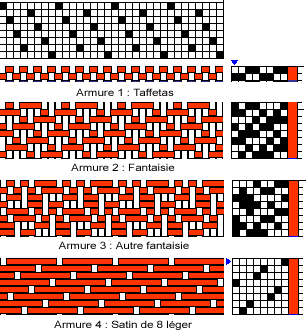
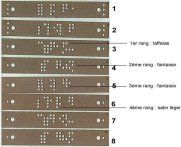
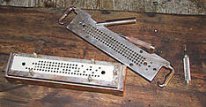

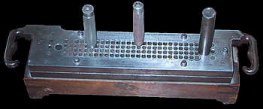
Reading of the Jacquard mechanics 104 hooks
The Jacquard Mechanism 104 is an armor mechanic for controlling a shed of heddles (frames) and accessories, it is not a mechanic of the actual shape, because of its small number of hooks.
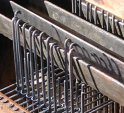
Reading boxes 104 Jacquard
The folding of the cartons 104 consists in piercing the cartons for the machine 104, using a matrix, as a function of the armor to be used.
The cardboard is clamped between the two plates and the holes are pierced using pieces. Using die plates the drilling is done with a mallet. To drill a given weave, one must know the filling and the collating of the mechanics, that is to say the place occupied by the hands controlling the hooks in relation to the healds. The pierced cartons are numbered on the side of the lantern (right side of the cardboard) and then interlaced, that is to say connected to each other by laces or the rope of embroidery which one passes in the external holes pierced to Side of the pedon holes.
Perceiving boxes with a matrix 104
Here, the case is a little special because it is desired to use a very special mechanism 104: a mechanical hook. This machine is intended for the manufacture of so-called "bayader" fabrics (horizontal stripes or stripes) and plaid fabrics, in which several armors alternate in turn according to various combinations.
In these tissues, the ratio can develop over a considerable number of blows (2 to 3000 for example in scarves). Constructed by ordinary means, these ratios would require chains of cartons very bulky and very expensive, whereas with hooked mechanics, the number of cartons is extremely reduced.
These mechanics (which can also be used as an ordinary mechanism) are provided with only one row of needles. The grid is vertically movable in 4 different positions, and can thus be positioned opposite each of the 4 rows of holes of the cylinder, by means of a system placed within reach of the weaver.
It follows that by using each row of holes for the stitching of a different weave, it is possible to select the frames according to the chosen weave by positioning the needle row in front of the row of holes And move from one armor to another.
In conclusion, we have 4 mechanical parts in one or, in order to achieve this result, 4 different sleeves of cartons should be available, and the carton should be replaced on every change of armor.
We will describe later this special mechanics, using photos, because we are lucky to have such a mechanism, dating from 1876, during cleaning and adjustment.
Here are the 8 boxes needed for our 4 armor:
Armor 1: taffeta, report on 2 shots (cartons 3,5,7 = 1, cartons 4,6,8 = 2)Armor 2: fancy on 8 shotsArmor 3: fancy on 8 shotsArmor 4: Light 8 satin on 8 shots
In these sketches, we find the 4 armor:From top to bottom, taffeta, fantasy 1, fantasy 2, and satin.In red, the ratio (repetition) of each armor.
Reassembly amalgamated on 8 frames.The selvedges are not shown.
This armor plot may be disconcerting if you use a pedal loom.It is carried out in the "Liftplan" mode present in most software (here PCW Fiberworks).We will study elsewhere this mode of tracing, but the simpleSketch below should already allow you to understand this route: